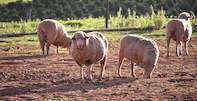The term free range in its most simple form implies that animals are free to move as they want, almost like wild animals in the Serengeti. It would be too difficult to manage farm animals in a system like that, which in turn will lead to losses and animal neglect.

Free range with livestock, therefore, essentially means that the animals spend a certain part of their lives or the day outside and are not crowded in small areas.
Most Karoo sheep by default can be considered “free range” as they are produced in highly extensive conditions. They, however, are not roaming free, their movement is still strategically controlled with the use of fencing.
Legislation
There is no legislation governing how free range livestock should be raised, which has resulted in the term being abused to make money in the past.
Many people also have different interpretations of what exactly “free range” means. With free range poultry or layer production, for instance, some people may be satisfied if birds are raised in houses with access to small areas outside. Others, however, may want the birds to be raised outside with access to shelter.
Labelling
The market has fortunately become more sophisticated and many retailers and producers, in response to this abuse, have developed their own “free range” brands with minimum standards that should be met for produce to qualify for this label.
These labels are registered as quality indication marks at the National Department of Agriculture, Forestry and Fisheries. To qualify for these marks, the product should be unique and fully traceable.
The South African Meat Industry Company (SAMIC) is assigned to audit these quality indication marks on the behalf of the National Department of Agriculture, at farms, abattoirs, feedlots, deboning plants and outlets.
Retailers that make use of this include Woolworth and Checkers, with brands that producers have registered individually or as a group including Great Karoo Natural Lamb, Het Goedgeloof Free Range Pasture Raised Pork, Hope’s Free Range, Karoo Natural Free, Oak Valley Free Range Beef, Oak Valley Free Range Pork.
Some industry bodies, such as the poultry industry, have also developed some minimum production standards to govern broiler and layer production, which includes standards for an operation to be considered as free range. The aims of these standards are to raise production efficiencies by improving animal welfare and biosecurity.